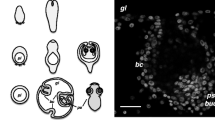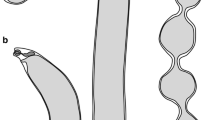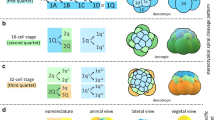Abstract.
Cestodes (tapeworms) are a derived, parasitic clade of the phylum Platyhelminthes (flatworms). The cestode body wall represents an adaptation to its endoparasitic lifestyle. The epidermis forms a non-ciliated syncytium, and both muscular and nervous system are reduced. Morphological differences between cestodes and free-living flatworms become apparent already during early embryogenesis. Cestodes have a complex life cycle that begins with an infectious larva, called the oncosphere. In regard to cell number, cestode oncospheres are among the simplest multicellular organisms, containing in the order of 50–100 cells. As part of our continuing effort to analyze embryonic development in flatworms, we describe here the staining pattern obtained with acTub in embryos and larvae of the cestode Hymenolepis diminuta and, briefly, the monogenean Neoheterocotyle rhinobatidis. In addition, we labeled the embryonic musculature of Hymenolepis with phalloidin. In Hymenolepis embryos, two different cell types that we interpret as neurons and epidermal gland cells express acTub. There exist only two neurons that develop close to the midline at the anterior pole of the embryo. The axons of these two neurons project posteriorly into the center of the oncosphere, where they innervate the complex of muscles that is attached to the hooklets. In addition to neurons, acTub labels a small and invariant set of epidermal gland cells that develop at superficial positions, anteriorly adjacent to the neurons, in the dorsal midline, and around the posteriorly located hooklets. During late stages of embryogenesis they spread and form a complete covering of the embryo. We discuss these data in the broader context of platyhelminth embryology.






Similar content being viewed by others
References
Ashburner M (1989) Drosophila. A laboratory manual. Cold Spring Harbor Laboratory Press, Cold Spring Harbor, NY
Ax P (1996) Multicellular animals, vol I. Gustav Fischer, Stuttgart
Bossing T, Udolph G, Doe CQ, Technau GM (1996) The embryonic central nervous system lineages of Drosophila melanogaster. I. Neuroblast lineages derived from the ventral half of the neuroectoderm. Dev Biol 179:41–64
Chisholm LA, Whittington ID (1996) Descriptions of the larvae of six species of monocotylid monogeneans from Himantura fai (Dasyatididae) and Rhinobatos typus (Rhinobatidae) from Heron Island, Great Barrier Reef, Australia. Syst Parasitol 35:145–156
Ehlers U (1985) Das phylogenetische System der Platyhelminthes. Gustav Fischer, Stuttgart
Fairweather I, Threadgold LT (1981) Hymenolepis nana: the fine structure of the penetration gland and nerve cells within the oncosphere. Parasitology 82:445–458
Grammeltvedt A-F (1973) Differentiation of the tegument and associated structures in Diphyllobothrium dendriticum Nitsch (1824) (Cestoda Pseudophyllidea). An electron microscopical study. Int J Parasit 3:321–327
Hartenstein V, Ehlers U (2000) The embryonic development of the rhabdocoel flatworm Mesostoma lingua. Dev Genes Evol 210:399–415
Kearn GC (1963a) The egg, oncomiracidium and larval development of Entobdella soleae, a monogenean skin parasite of the common sole. Parasitology 53:435–447
Kearn GC (1963b) The life cycle of the monogenean Entobdella soleae, a skin parasite of the common sole. Parasitology 53:253–263
Llewellyn J (1963) Larvae and larval development of monogeneans. Adv Parasitol 1:287–326
Lyons KM (1973) Epidermal fine structure and development in the oncomiracidium larva of Entobdella soleae (Monogenea). Parasitology 66:321–333
Ogren RE (1955) Development and morphology of glandular regions in oncospheres of Hymenolepis nana. Acad Sci 29:258–264
Ogren RE (1958) The hexacanth embryo of a dilepidid tapeworm. I. The development of hooklets and contractile parenchyma. J Parasitol 44:477–483
Reid WM (1948) Penetration glands in cyclophyllidean oncospheres. Trans Am Microsc Soc 67:177–182
Rohde K, Georgi M (1983) Structure and development of Austramphilina elongata Johnston, 1931 (Cestodaria: Amphilinidae). Int J Parasit 13:273–287
Rybicka K (1966) Embryogenesis in Cestodes. Adv Parasitol 4:107–186
Rybicka K (1973) Ultrastructure of the embryonic syncytial epithelium in a cestode Hymenolepis diminuta. Parasitology 66:9–18
Swiderski Z (1973) Electron microscopy and histochemistry of oncospheral hook formation by the cestode Catenotaenia pusilla. Int J Parasitol 3:27–33
Ubelaker JE (1980) Structure and ultrastructure of the larvae and metacestodes of Hymenolepis diminuta. In: Arai HP (ed) Biology of the tapeworm Hymenolepis diminuta. Academic, New York, pp 59–156
Xylander WER (1986) Ultrastructural results concerning the position of Gyrocotyle within the parasitic Platyhelminthes. Verh Dtsch Zool Ges, München 79:193–201
Xylander WER (1987) Ultrastructure of the lycophora larva of Gyrocotyle urna (Cestoda, Gyrocotylidea). I. Epidermis, neodermis, and body musculature. Zoomorphology 106:352–360
Younossi-Hartenstein A, Hartenstein V (2000) The embryonic development of the polyclad flatworm Imogine mcgrathi Dev Genes Evol 210:383–398
Younossi-Hartenstein A, Hartenstein V (2001) The embryonic development of the temnocephalid flatworms Craspedella pedum and Diceratocephala boschmai. Cell Tissue Res 304:295–310
Younossi-Hartenstein A, Ehlers U, Hartenstein V (2000) Embryonic development of the nervous system of the rhabdocoel flatworm Mesostoma lingua (Abildgaard, 1789). J Comp Neurol 416:461–476
Younossi-Hartenstein A, Jones M, Hartenstein V (2001) The embryonic development of the nervous system of the temnocephalid flatworm Craspedella pedum. J Comp Neurol 434:56–68
Zalokar M, Erk I (1977) Phase-partition fixation and staining of Drosophila eggs. Stain Technol 52:89–95
Acknowledgements.
We would like to thank Dr. Ian Whittington, then director of the Heron Island Marine Research Station, for help in obtaining specimens of Neoheterocotyle.
Author information
Authors and Affiliations
Corresponding author
Additional information
This work was supported by NSF grant IBN-0110718 to V.H.
Rights and permissions
About this article
Cite this article
Hartenstein, V., Jones, M. The embryonic development of the bodywall and nervous system of the cestode flatworm Hymenolepis diminuta . Cell Tissue Res 311, 427–435 (2003). https://doi.org/10.1007/s00441-002-0687-8
Received:
Accepted:
Published:
Issue Date:
DOI: https://doi.org/10.1007/s00441-002-0687-8




